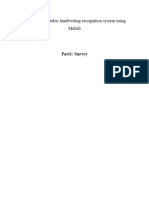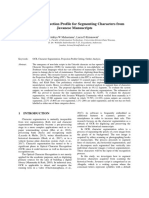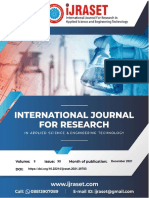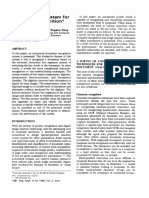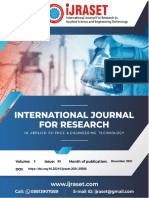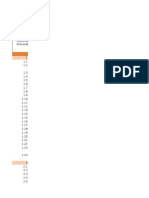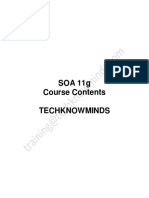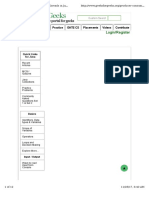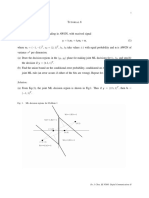Optical Character Recognition Technique Algorithms
Optical Character Recognition Technique Algorithms
Uploaded by
AnushiMaheshwariCopyright:
Available Formats
Optical Character Recognition Technique Algorithms
Optical Character Recognition Technique Algorithms
Uploaded by
AnushiMaheshwariOriginal Title
Copyright
Available Formats
Share this document
Did you find this document useful?
Is this content inappropriate?
Copyright:
Available Formats
Optical Character Recognition Technique Algorithms
Optical Character Recognition Technique Algorithms
Uploaded by
AnushiMaheshwariCopyright:
Available Formats
Journal of Theoretical and Applied Information Technology
20th January 2016. Vol.83. No.2
2005 - 2015 JATIT & LLS. All rights reserved.
ISSN: 1992-8645
www.jatit.org
E-ISSN: 1817-3195
OPTICAL CHARACTER RECOGNITION TECHNIQUE
ALGORITHMS
1
N. VENKATA RAO, 2DR. A.S.C.S.SASTRY, 3A.S.N.CHAKRAVARTHY, 4
KALYANCHAKRAVARTHI P
Research Scholar, Department of ECE , K.L.University, Vaddeswaram, Andhra Pradesh, India
2
Professor, Department of ECE, K.L.University, Vaddeswaram, Andhra Pradesh, India
3
Professor, Department of CSE , University college of Engineering,Vizianagaram, Andhra Pradesh, India
4
Assistant Professor, Department of ECE, GMR Institute of Technology, Rajam, India Pradesh, India
E-mail: 1venkatnekkanti@rediffmail.com, 2 ascssatry @kluniversity.in,
3
chakravarthy.cse@jntukucev.ac.in, 4 kalyanecebujji@gmail.com
ABSTRACT
In this paper, we present a new neural network (NN) based method for optical character recognition (OCR)
as well as handwritten character recognition (HCR). Experimental results show that our proposed method
achieves increased accuracy in optical character recognition as well as handwritten character recognition.
We present through an overview of existing handwritten character recognition techniques. All the
algorithms describes more or less on their own. Handwritten character recognition is a very popular and
computationally expensive task; we describe advanced approaches for handwritten character recognition.
In the present work, we would like to compare the most important once out of the variety of advanced
existing techniques, and we will systematize the techniques by their characteristic considerations. It leads to
the behaviour of the algorithms reaches to the expected similarities.
Keywords- OCR, HCR, Neural Network. Recognition Technique
1.
INTRODUCTION
Character recognition is an art of detecting
segmenting and identifying characters from image.
More precisely, character recognition is a process
of detecting and recognizing characters from input
image and converts it into American Standard Code
for Information Interchange (ASCII) or other
equivalent machine editable form [1], [2], [3]. It
contributes immensely to the advancement of
automation process and improving the interface
between man and machine in many applications
[4]. Character recognition is one of the most
interesting and fascinating areas of pattern
recognition and artificial intelligence [5],
[6]. Character recognition is getting more and more
attention since last decade due to its
wide range of applications.
Conversion of handwritten characters is important
for making several important documents related to
our history, such as manuscripts into machine
editable form, so that, it can be easily accessed and
pres independent work is going on in Optical
Character Recognition that is the processing of
printed/computer generated document, handwritten
and manually created document processing i.e.
handwritten character recognition. Figure 1 (a) and
1(b) represents the offline and online character
recognitions.
Figure 1. (a) Offline character recognition, (b) Online
character recognition.
Offline character recognition system generates the
document first, digitalizes, and stored in computer
and then it is processed. Whereas, in case of online
character recognition system, character is processed
while it was under creation. External factors like
pressure, speed of writing have any influence in
case of offline system but they have great impact on
online system. Again, offline or online system can
275
Journal of Theoretical and Applied Information Technology
20th January 2016. Vol.83. No.2
2005 - 2015 JATIT & LLS. All rights reserved.
ISSN: 1992-8645
www.jatit.org
be applied on optical character (Fig 2. (a)) or
handwritten characters (Fig 2.(b)). Based on that,
systems can be classified as OCR or HCR
respectively. Online methods are superiors to their
counterparts i.e. offline methods due to the
temporal information present in the character
generation [4].
Accuracy of HCR is still limited to 90
percent due to presence of large variation in shape,
scale, style and orientation etc., [8]. Character
processing systems are domain and application
specific, like the other systems it is not possible to
design generic systems which can process all kinds
of scripts and languages. Lots of work has been
carried out on European languages and Arabic
(Urdu) language. Whereas domestic languages like
Hindi, Punjabi, Bangla, Tamil and Gujarati etc., are
very less explored due to limited usage. In this
paper, our focus is to carry out in depth literature
survey on handwritten character recognition
methods.
Figure 2. (a) Optical character (b) Handwritten
character.
Image processing and pattern recognition
plays significant role in handwritten character
recognition. Rajbala et al [10], have discussed
various types of classification of feature extraction
methods like statistical feature based methods,
structural feature based methods and global
transformation techniques. Statistical methods are
based on the planning of how the data should be
selected. It uses the information of statistical
distribution of pixels in image, it can be mainly
classified in three categories: 1). Partitioning in
regions, 2). Profile generation and projections 3)
distances and crossing. Structural features are
extracted from structure and geometry of character
like number of horizontal and vertical lines, aspect
ratio, number of cross points, number of loops,
number of branch points, number of strokes and
number of curves etc. Global transformation
features are calculated by converting the image in
frequency domains like Discrete Fourier
Transformation
(DFT),
Discrete
Cosine
Transformation
(DCT),
Discrete
Wavelet
Transformation (DWT), Gabor filtering,
and
Walsh-Hadamard transformation etc.
E-ISSN: 1817-3195
Features extracted can be either low level
or high level. Low level features include width,
height, curliness and aspect ratio etc., of the
character. These alone cannot be used to distinguish
one character from another in the character set of
the languages [11]. So, there are the number of
other high level features which includes number
and position of loops, straight lines, headlines and
curves etc. Tirthraj Dash et al discussed HCR using
associative memory net (AMN) in their paper [12],
represents the direct work at pixel level. Dataset
was designed in MS Paint 6.1 with normal Arial
font size 28(twenty eight). Dimension of image was
kept 31X39. Once characters are extracted, their
binary pixel values are directly used to train AMN.
I. K. Pathan et al have proposed offline approach
for handwritten isolated Urdu characters in their
wok [13]. Urdu character may contain one, two,
three or four segments, in which one component is
known as primary (generally represents large
continuous stroke) and rest of all are known as
secondary components (generally represents small
stroke or dots). Authors have used moment
invariant (MI) feature to recognize the characters.
MI features are well known to be invariant under
rotation, translation, scaling and reflection. MI
features are the measure of pixel distribution
around the centre of gravity of character and it
captures the global character shape information. If
character image is single component than it is
normalized in 60X 60 pixels and horizontally
divided into three (3) equal parts. 7 MIs are
extracted from each zone and 7 MIs are calculated
from overall image, so, total of 28 features are used
to train support vector machines (SVM), if image is
having multi components then 28 MIs are extracted
from primary component (60 X 60) and 21 MIs are
extracted from secondary component (22 X 22).
Separate SVMs are trained for both and decision is
taken based on the rules satisfying some criteria.
Proposed system claim to get highest accuracy of
93.59 %. In paper [4], Pradeep et al has proposed
neural network based classification of handwritten
character recognition system. Each individual
character is resized to 30 X 20 pixels for
processing; they have used the binary features to
train the neural network. However, such features
are not robust. In post processing stage, recognized
characters are converted to ASCII format. Input
layer has 600 neurons equal to number of pixels.
Output layer has 26 neurons as English has 26
alphabets. The proposed ANN uses back
propagation algorithm.
2. COMPARISION OF OCR TECHNIQUES
276
Journal of Theoretical and Applied Information Technology
20th January 2016. Vol.83. No.2
2005 - 2015 JATIT & LLS. All rights reserved.
ISSN: 1992-8645
www.jatit.org
Various techniques used for the design of
OCR by their characteristics.
Matrix Matching
Matrix Matching converts each character
into a pattern within a matrix, and then compares
the pattern with an index of known characters. Its
recognition is strongest on monotype and uniform
single column pages.
Fuzzy Logic
E-ISSN: 1817-3195
A neural network is a powerful data modelling tool
that is able to capture and represent complex
input/output relationships. Motivation for the
development of neural network technology
stemmed from the desire to develop an artificial
system that could perform "intelligent" tasks similar
to those performed by the human brain. Neural
networks resemble the human brain in the
following two ways: (1) A neural network acquires
knowledge through learning; (2) A neural network's
knowledge is stored within inter-neuron connection
strengths known as synaptic weights.
Fuzzy logic is a multi-valued logic that
allows intermediate values to be defined between
conventional evaluations like yes/no, true/false,
black / white etc. An attempt is made to attribute a
more human-like way of logical thinking in the
programming of computers. Fuzzy logic is been
used when answers do not have a distinct true or
false values and there are uncertainly involved.
Feature Extraction
This method defines each character by the
presence or absence of key features, including
height, width, density, loops, lines, stems and other
character traits. Feature extraction is a perfect
approach for OCR of magazines, laser print and
high quality images.
Structural Analysis
Structural Analysis identifies characters by
examining their sub feature shapes of the image,
sub-vertical and horizontal histograms. Its character
repair capability is great for low quality text and
newsprints.
Figure 3: MLP Network
The most common neural network model
is the multilayer perception (MLP), this type of
neural network is known as a supervised network
because it requires a desired output in order to
learn. The goal of this type of network is to create a
model that correctly maps the input to the output
using historical data so that the model can be used
to produce the output when the desired output is
unknown. A graphical representation of an MLP is
shown below.
Neural Networks
This strategy simulates the way the human
neural system works; it samples the pixels in each
image and matches them to a known index of
character pixel patterns. The ability to recognize the
characters through abstraction is great for fixed
documents and damaged text. Neural networks are
ideal for specific types of problems, such as
processing stock market data or finding trends in
graphical patterns.In all these approaches Neural
Networks are efficient than others.
Figure 4: Structure of ANN
3. ARTIFICIAL NEURAL NETWORK
4. COMPONENTS OF OCR SYSTEM
Optical scanning
277
Journal of Theoretical and Applied Information Technology
20th January 2016. Vol.83. No.2
2005 - 2015 JATIT & LLS. All rights reserved.
ISSN: 1992-8645
www.jatit.org
E-ISSN: 1817-3195
Through the scanning process is the digital
image of the original document is captured.
Whereas OCR optical scanners generally consist of
a transport mechanism plus a sensing device that
converts light intensity into gray-levels. Printed
documents usually consist of black print on a white
background; hence, when performing OCR, it is
common practice to convert the multilevel image
into a bi-level image of black and white. Often, this
process is known as thresholding, is performed on
the scanner to save memory space and
computational effort.
Location and segmentation
Segmentation is a process that determines the
constituents of an image, it is necessary to locate
the regions of the document where data have been
printed and distinguish them from figures and
graphics. For instance, when performing automatic
mail-sorting, the address must be located and
separated from other print on the envelope like
stamps and company logos, prior to recognition.
Pre-processing
The image resulting from the scanning process
may contain a certain amount of noise depending
on the resolution of the scanner and the success of
the applied technique for thresholding, the
characters may be smeared or broken. Some of
these defects, which may later cause poor
recognition rates, can be eliminated by using a preprocessor to smooth the digitized characters.
Feature extraction
The objective of feature extraction is to
capture the essential characteristics of the symbols,
and it is generally accepted that this is one of the
most difficult problems of pattern recognition. The
most straight forward way of describing a character
is by the actual raster image. Another approach is to
extract certain features that still characterize the
symbols, but leaves out the unimportant attributes.
Post processing
They are two types of post processing,
1. Grouping
2. Error-detection and
correction.
Figure 5: Component of OCR
5. PROPOSED SYSTEM FUTURE SCOPE OF
WORK
Aim of the proposed system is to develop a
neural network based method for accurate optical
character recognition. The algorithm will learn
from the training data set and will provide 100
percent accurate optical character recognition
result. Here we develop a neural network based
method for accurate hand written character
recognition. OCR is the acronym for Optical
Character Recognition; this technology allows a
machine to automatically recognize characters
through an optical mechanism. Human beings
recognize many objects in this manner our eyes are
the "optical mechanism." But while the brain "sees"
the input, the ability to comprehend these signals
varies in each person according to many factors. By
reviewing these variables, we can understand the
challenges faced by the technologist developing an
OCR system. The ultimate objective of an OCR
system is to simulate the human reading capabilities
so the computer can read, understand, edit and do
similar activities it does with the text. Block
diagram of the typical OCR system shown in fig 4.
Each stage has its own problems and effects on the
overall systems efficiency. Thus, to tackle all the
problems, either by solving each particular
problem. OCR system by integrating all stages to
one main stage, and this is what our research
proposes. This paper presents new structure of OCR
system which relies on the powerful proprieties.
The algorithm is designed and tested in the related
sections.
278
Journal of Theoretical and Applied Information Technology
20th January 2016. Vol.83. No.2
2005 - 2015 JATIT & LLS. All rights reserved.
ISSN: 1992-8645
www.jatit.org
E-ISSN: 1817-3195
Figure 6: Structure of the proposed system.
Creation network consists of the following structure
for our proposed algorithm
Fig 7: Network used for proposed algorithm.
6. PROPOSED ALGORITHM
The input pattern is presented to the input
layer of the network.
These inputs are propagated through the
network until they reach the output units.
This forward pass produces the actual or
predicted output pattern, because, back
propagation is a supervised learning
algorithm, the desired outputs are given as
part of the training vector.
The actual network outputs are subtracted
from the desired outputs and an error signal
is produced.
This error signal is the basis for the back
propagation step, whereby the errors are
passed back through the neural network by
computing the contribution of each hidden
279
processing
unit
and
deriving
the
corresponding adjustments needed to
produce the correct output.
The connection weights are then adjusted
and the neural network has just learned
from an experience. Once the network is
trained, it will provide the desired output for
any of the input patterns.
The network undergoes supervised training,
with a finite number of pattern pairs
consisting of an input pattern and a desired
or target output pattern.
An input pattern is presented at the input
layer. The neurons here pass the pattern
activations to the next layer neurons, which
are in a hidden layer.
The outputs of the hidden layer neurons are
obtained by the weights and the inputs, these
hidden layer outputs become inputs to the
output neurons, which process the inputs
using an optional bias and a threshold
function.
The final output of the network is
determined by the activations from the
output layer.
A similar computation, still based on the
error in the output, is made for the
connection weights between the input and
hidden layers.
The procedure is repeated with each pattern
pair assigned for training the network. Each
pass through all the training patterns is
called a cycle or an epoch. The process is
then repeated as many cycles as needed until
the error is within a prescribed tolerance.
The adjustment for the threshold value of a
neuron in the output layer is obtained by
multiplying the calculated error in the output
at the output neuron and the learning rate
and the momentum parameter used in the
adjustment calculation for weights at this
layer.
= e
After the network has learned the correct
classification for a set of inputs from a
training set, it can be tested on a second set
of inputs to see how well it classifies
untrained patterns.
Journal of Theoretical and Applied Information Technology
20th January 2016. Vol.83. No.2
2005 - 2015 JATIT & LLS. All rights reserved.
ISSN: 1992-8645
www.jatit.org
E-ISSN: 1817-3195
7. APPLICATIONS
Optical character recognition has been applied to
number of applications. Some of them have been
explained below.
A. Invoice Imaging
Invoice imaging is widely used in many
business applications to keep track of financial
records and prevent a backlog of payments from
piling up. In government agencies and independent
organizations, OCR simplifies data collection and
analysis, among other processes. As the technology
continues to develop, more and more applications
are found for OCR technology, including increased
use of hand writing recognition. Furthermore, other
technologies related to OCR, such as barcode
recognition used daily in retail and other industries.
B. Legal Industry
Legal industry is also one of the
beneficiaries of the OCR technology. OCR is used
to digitize documents, and directly entered to
computer database. Legal professional scan further
search documents required from huge data bases by
simply typing a few keywords.
E. Captcha
A CAPTCHA is a program that can
generate and grade tests that human can pass but
current computer programmers cannot. Hacking is
a serious threat to internet usage, now a days, most
of the human activities like economic transactions,
admission for education, registrations, travel
bookings etc., are carried out through internet and
all this requires a password which is misused by
hackers. They create programs to like dictionary
attacks and automatic false enrolments which lead
to waste of memory and resources of website.
Dictionary attack is attack against password
authenticated systems where a hacker writes a
program to repeatedly try different passwords like
from dictionary of most common passwords. In
CAPTCHA, an image consisting of series of letters
of number is generated which is obscured by image
distortion techniques, size and font variation,
distracting backgrounds, random segments,
highlights and noise in the image. This system can
be used to remove this noise and segment the image
to make the image tractable for the OCR (Optical
Character Recognition) systems.
F. Institutional Repositories and Digital
Libraries
C. Banking
Another important application of OCR is
in banking, where it is used to process cheques
without human involvement. A cheque can be
inserted into a machine where the system scans the
amount to be issued and the correct amount of
money is transferred. This technology has nearly
been perfected for printed checks, and is fairly
accurate for hand written checks as well reducing
the waiting time in banks.
D. Healthcare
Healthcare has also seen an increase in the
use of OCR technology to process paperwork.
Healthcare professionals always have to deal with
large volumes of forms for patients, including
insurance forms as well as general health forms. To
keep up with all of this information, it is useful to
input relevant data into an electronic database that
can be accessed as necessary. Form processing
tools, powered by OCR, are able to extract
information from forms and put it into databases, so
that every patient's data is promptly recorded.
Institutional repositories are digital
collections of the outputs created within a
university or research institution. It is an online
locale of intellectual data of an institution,
especially a research institution where it is
collected, preserved and aired. It helps to open up
the outputs of an institution and give it visibility
and more impact on worldwide level. Enables and
encourages inter disciplinary approaches to
research and facilitates the development and
sharing of digital teaching materials and aids. It is
basically a collection of peer reviewed journal
articles, conference proceedings, research data,
monographs, books, theses and dissertations and
presentations. Their first role is to provide the Open
Access literature. Practical implementation of this
includes setting up a system which consists of
scanner which scans the documents. This scanned
document is then fed as an input to an Optical
Character Recognition system where information is
acquired and retained in digitized form.
G. Optical Music Recognition
280
Journal of Theoretical and Applied Information Technology
20th January 2016. Vol.83. No.2
2005 - 2015 JATIT & LLS. All rights reserved.
ISSN: 1992-8645
www.jatit.org
E-ISSN: 1817-3195
Table 1: Experimental Result of OCR System
Automated learning system extract
No. of
Recogni
Not
Rate
information from images and is part of major Character
patterns
tion
Recogni
(%) of
researches. Optical music recognition (OMR) born
given
zed
Recogni
in 1950s is a developed field and initially was
tion
aimed towards recognizing printed sheets which
L
5
5
0
100%
can be edited into playable form with the help of
electronic and electrochemical methods. An OMR
M
5
5
0
100%
system has many applications like processing of
O
5
5
0
100%
different classes of music, large scale digitization of
musical data and also it can be used for diversity in
Table 2: Printed And Handwritten Document Results
musical notation. Image enhancement and
segmentation is the basic step and hence the paper
TWDB
focuses on it.
Test Set
Train Set
Recognition
Rate
H. Automatic Number Recognition
2793 chars
11173 chars
95.44%
HWDB
Automatic number plate recognition is
Test Set
Train Set
Recognition
used as a mass surveillance technique making use
Rate
of optical character recognition on images to
1351 chars
5407 chars
94.62 %
identify vehicle registration plates. ANPR has also
been made to store the images captured by the
cameras including the numbers captured from
license plate. ANPR technology own to plate
variation from place to place
as it is a region specific technology. They are used
by various police forces and as a method of
electronic toll collection on pay-per-use roads and
cataloguing the movements of traffic or individuals.
I. Handwriting Recognition
Handwriting recognition is the ability of a
computer to receive and interpret intelligible
handwritten input from sources such as paper
documents, photographs, touch-screens and other
devices. The image of the written text may be
sensed "off line" from a piece of paper by optical
scanning (optical character recognition) or
intelligent word recognition. Alternatively, the
movements of the pen tip maybe sensed "on line",
for example by a pen-based computer screen
surface.
8. RESULT
We take 3 characters with its 5 pattern and
examine that character set.
9. CONCLUSION
In this paper we surveyed a large number of
methods of optical character recognition. We
analyzed the advantages and drawbacks of various
OCR methods. We also proposed a modified back
propagation method. It is widely used in neural
network. The proposed method computes error
rate efficiently, it results in increasing the accuracy
of neural network. Our proposed neural network
based method is providing 100 % accuracy in
OCR.
REFERENCES
[1] Kai Ding, Zhibin Liu, LianwenJin, Xinghua
Zhu, A Comparative study of GABOR
feature and gradient feature for handwritten
17hinese character recognition, International
Conference on Wavelet Analysis and Pattern
Recognition, pp. 1182-1186, Beijing, China,
2-4 Nov. 2007
[2] Pranob K Charles, V.Harish, M.Swathi, CH.
Deepthi, "A Review on the Various
Techniques used for Optical Character
Recognition", International Journal of
Engineering Research and Applications, Vol.
2, Issue 1, pp. 659-662, Jan-Feb 2012
[3] Om Prakash Sharma, M. K. Ghose, Krishna
Bikram Shah, "An Improved Zone Based
Hybrid Feature Extraction Model for
Handwritten Alphabets Recognition Using
Euler Number", International Journal of Soft
Computing and Engineering, Vol.2, Issue 2,
281
Journal of Theoretical and Applied Information Technology
20th January 2016. Vol.83. No.2
2005 - 2015 JATIT & LLS. All rights reserved.
ISSN: 1992-8645
www.jatit.org
pp. 504-58, May 2012
[4] J. Pradeepa, E. Srinivasana, S. Himavathib,
"Neural Network Based Recognition System
Integrating
Feature
Extraction
and
Classification for English Handwritten",
International journal of Engineering,Vol.25,
No. 2, pp. 99-106, May 2012
[5] Liu Cheng-Lin, Nakashima, Kazuki, H, Sako,
H.Fujisawa, Handwritten digit recognition:
investigation of normalization and feature
extraction techniques, Pattern Recognition,
Vol. 37, No. 2, pp. 265-279, 2004.
[6] SupriyaDeshmukh, Leena Ragha, "Analysis of
Directional Features - Stroke and Contour for
Handwritten Character Recognition", IEEE
International
Advance
Computing
Conference, pp.1114-1118, 6-7 March, 2009,
India
[7] AmrithaSampath, Tripti C, Govindaru V,
Freeman code based online handwritten
character recognition for Malayalam using
Back propagation neural networks, Advance
computing: An international journal, Vol. 3,
No. 4, pp. 51-58, July 2012
[8] RajibLochan Das, Binod Kumar Prasad,
GoutamSanyal, "HMM based Offline
Handwritten Writer Independent English
Character Recognition using Global and
Local Feature Extraction", International
Journal of Computer Applications (0975
8887), Volume 46 No.10, pp. 45-50, May
2012
[9] Bhatia, N. and Vandana, Survey of Nearest
Neighbor Techniques, International Journal
of Computer Science and Information
Security, Vol. 8, No. 2, (2001),302-305.
[10] RajbalaTokas,ArunaBhadu, "A comparative
analysis of feature extraction techniques for
handwritten
character
recognition",
International
Journal
of
Advanced
Technology & Engineering Research,
Volume 2, Issue 4, pp. 215-219, July 2012
[11] AmrithaSampath, Tripti C, Govindaru V,
"Freeman code based online handwritten
character recognition for Malayalam using
backpropagation
neural
networks",
International
journal
on
Advanced
computing, Vol. 3, No. 4, pp. 51 - 58, July
2012
[12] Tirtharaj Dash, Time efficient approach to
offline hand written character recognition
using associative memory net.,International
Journal of Computing and Business
Research, Volume 3 Issue 3 September 2012
[13] Imaran Khan Pathan,Abdulbari Ahmed Bari
E-ISSN: 1817-3195
Ahmed Ali, Ramteke R.J., "Recognition of
offline handwritten isolated Urdu character ",
International Journal on Advances in
Computational Research, Vol. 4, Issue 1, pp.
117-121, 2012
[14] Ashutosh Aggarwal, Rajneesh Rani,
RenuDhir,
"Handwritten
Devanagari
Character Recognition Using Gradient
Features", International Journal of Advanced
Research in Computer Science and Software
Engineering (ISSN: 2277-128X), Vol. 2, Issue 5,
pp. 8590, May 2012
[15] Dan ClaudiuCiresan and Ueli Meier and
LucaMaria
Gambardella
and
JurgenSchmidhuber,Convolutional
Neural
Network
Committees
forHandwritten
Character Classification, 2011International
Conference on Document Analysis and
Recognition, IEEE, 2011.
282
You might also like
- Ipsl TrainingDocument102 pagesIpsl TrainingKamil Wolszczak33% (3)
- CSE Final Year Project ProposalDocument10 pagesCSE Final Year Project Proposalখালেকুজ্জামান সৈকতNo ratings yet
- Tài liệu về OCR 6Document6 pagesTài liệu về OCR 6Minh ChâuNo ratings yet
- A Survey On Handwritten Character Recognition Using Deep Learning TechniqueDocument6 pagesA Survey On Handwritten Character Recognition Using Deep Learning TechniqueMs. Divya KonikkaraNo ratings yet
- A Literature Review On Hand Written Character RecognitionDocument19 pagesA Literature Review On Hand Written Character RecognitiongalNo ratings yet
- Recognition of Devanagari Printed Text Using Neural Network and Genetic AlgorithmDocument4 pagesRecognition of Devanagari Printed Text Using Neural Network and Genetic AlgorithmvishwanathNo ratings yet
- January 2023: Top 10 Cited Articles in Computer Science & Information TechnologyDocument32 pagesJanuary 2023: Top 10 Cited Articles in Computer Science & Information TechnologyAnonymous Gl4IRRjzNNo ratings yet
- Handwritten Text Recognition System Based On Neural NetworkDocument6 pagesHandwritten Text Recognition System Based On Neural NetworkPrasanna KumarNo ratings yet
- Bayesian Decision Theory Based Handwritten Character RecognitionDocument8 pagesBayesian Decision Theory Based Handwritten Character RecognitionBarath GunasekaranNo ratings yet
- Tarang JI - EditedDocument20 pagesTarang JI - EditedprakharcoolsNo ratings yet
- HCR (English) Using Neural Network PDFDocument7 pagesHCR (English) Using Neural Network PDFDr. Hitesh MohapatraNo ratings yet
- Paper 4757Document6 pagesPaper 4757aswinsudharshiniNo ratings yet
- Devnagari Handwritten Numeral Recognition Using Geometric Features and Statistical Combination ClassifierDocument8 pagesDevnagari Handwritten Numeral Recognition Using Geometric Features and Statistical Combination ClassifierkprakashmmNo ratings yet
- Optical Character Recognition Using Artificial Neural NetworkDocument4 pagesOptical Character Recognition Using Artificial Neural NetworkFarhad Ahmed ChirleyNo ratings yet
- CH 1Document4 pagesCH 1sami hasanNo ratings yet
- Diagonal Based Feature Extraction For Handwritten Alphabets Recognition System Using Neural NetworkDocument12 pagesDiagonal Based Feature Extraction For Handwritten Alphabets Recognition System Using Neural NetworkAnonymous Gl4IRRjzNNo ratings yet
- A Survey On Odia Handwritten Character RecognitionDocument2 pagesA Survey On Odia Handwritten Character RecognitionIJARTESNo ratings yet
- CNN Based Digital Alphanumeric Archaeolinguistics Apprehension For Ancient Script DetectionDocument7 pagesCNN Based Digital Alphanumeric Archaeolinguistics Apprehension For Ancient Script Detectionaparna miduthuruNo ratings yet
- Machine Learning For Handwriting Recognition: Preetha S, Afrid I M, Karthik Hebbar P, Nishchay S KDocument9 pagesMachine Learning For Handwriting Recognition: Preetha S, Afrid I M, Karthik Hebbar P, Nishchay S KAustin Abhishek KispottaNo ratings yet
- Biometric Identification For Recognizing Text Usingvarious AI AlgorithmDocument6 pagesBiometric Identification For Recognizing Text Usingvarious AI AlgorithmInternational Journal of Innovative Science and Research TechnologyNo ratings yet
- Improving Projection Profile For Segmenting Characters From Javanese ManuscriptsDocument6 pagesImproving Projection Profile For Segmenting Characters From Javanese ManuscriptsAprianti V WNo ratings yet
- ArabicDocument6 pagesArabicMed KHNo ratings yet
- Handwritten Text Recgnition FinalDocument5 pagesHandwritten Text Recgnition Final21211a05g9No ratings yet
- Text Recognition Using Image Processing Technology For Visiting CardDocument7 pagesText Recognition Using Image Processing Technology For Visiting CardIJRASETPublicationsNo ratings yet
- Applying AI To Biometric Identification For Recognizing Text Using One-Hot Encoding and CNNDocument9 pagesApplying AI To Biometric Identification For Recognizing Text Using One-Hot Encoding and CNNInternational Journal of Innovative Science and Research TechnologyNo ratings yet
- Digitizing Notes Using Optical Character Recognition and Automatic Topic Identification and Classification Using Natural Language ProcessingDocument10 pagesDigitizing Notes Using Optical Character Recognition and Automatic Topic Identification and Classification Using Natural Language ProcessingIJRASETPublicationsNo ratings yet
- Handwritten Marathi Compound Character PDFDocument6 pagesHandwritten Marathi Compound Character PDFInternational Journal of Innovations in Engineering and ScienceNo ratings yet
- 1 Ijcseitrfeb20171Document8 pages1 Ijcseitrfeb20171TJPRC PublicationsNo ratings yet
- Offline Handwritten Hindi Character Recognition Using Data Mining152Document50 pagesOffline Handwritten Hindi Character Recognition Using Data Mining152AshutoshSharmaNo ratings yet
- (IJCST-V12I2P9) :Dr.M. Praneesh, Ashwanth.V, Febina.N, Sai Krishna P KDocument8 pages(IJCST-V12I2P9) :Dr.M. Praneesh, Ashwanth.V, Febina.N, Sai Krishna P Keditor1ijcstNo ratings yet
- Optical Character Recognition (OCR) SystemDocument5 pagesOptical Character Recognition (OCR) SystemInternational Organization of Scientific Research (IOSR)No ratings yet
- Ijaret: ©iaemeDocument9 pagesIjaret: ©iaemeIAEME PublicationNo ratings yet
- Paper 5Document5 pagesPaper 5mukundaspoorthiNo ratings yet
- Obaid Et Al., ANN Based Handwritten Notes Recognition, 2016Document7 pagesObaid Et Al., ANN Based Handwritten Notes Recognition, 2016Suyog GargNo ratings yet
- Writing Order Recovery From Telugu Character ImagesDocument9 pagesWriting Order Recovery From Telugu Character ImageseditorinchiefijcsNo ratings yet
- Accuracy Augmentation of Tamil OCR Using Algorithm FusionDocument6 pagesAccuracy Augmentation of Tamil OCR Using Algorithm FusionsubakishaanNo ratings yet
- Fin Irjmets1669440970Document6 pagesFin Irjmets166944097013 146Aditya ChaudhariNo ratings yet
- Optical Character Recognition Using 40-Point Feature Extraction and Artificial Neural NetworkDocument8 pagesOptical Character Recognition Using 40-Point Feature Extraction and Artificial Neural NetworkAravinda GowdaNo ratings yet
- Radially Defined Local Binary Patterns For Hand Gesture RecognitionDocument5 pagesRadially Defined Local Binary Patterns For Hand Gesture RecognitionWARSE JournalsNo ratings yet
- Handwritten English Alphabet RecognitionDocument8 pagesHandwritten English Alphabet RecognitionIJRASETPublicationsNo ratings yet
- Kannada Text RecognitionDocument7 pagesKannada Text RecognitionIJRASETPublicationsNo ratings yet
- Design of An OCR System and Its Hardware ImplementationDocument18 pagesDesign of An OCR System and Its Hardware ImplementationIJRASETPublicationsNo ratings yet
- SL NO. Name Usn Number Roll NoDocument10 pagesSL NO. Name Usn Number Roll NoVîñåÿ MantenaNo ratings yet
- Telugu Letters Dataset and Parallel Deep Convolutional Neural Network With A SGD Optimizer Model For TCRDocument10 pagesTelugu Letters Dataset and Parallel Deep Convolutional Neural Network With A SGD Optimizer Model For TCRIJRES teamNo ratings yet
- Technical Department: The Institution of Engineers (India) R&D Grant-In-Aid SchemeDocument9 pagesTechnical Department: The Institution of Engineers (India) R&D Grant-In-Aid SchemeSai Ram Prasad ReddyNo ratings yet
- An Effective Approach in Face Recognition Using Image Processing ConceptsDocument5 pagesAn Effective Approach in Face Recognition Using Image Processing ConceptsInternational Journal of Application or Innovation in Engineering & ManagementNo ratings yet
- Gara in 2002Document11 pagesGara in 2002nikhil tiwariNo ratings yet
- Document RecongDocument11 pagesDocument RecongSai Raja GNo ratings yet
- Handwritten Devanagari Compound Character Recognition Using Legendre Moment An Artificial Neural Network ApproachDocument5 pagesHandwritten Devanagari Compound Character Recognition Using Legendre Moment An Artificial Neural Network ApproachNayeli HernándezNo ratings yet
- Enhanced Face Recognition Algorithm Using PCA With Artificial Neural NetworksDocument9 pagesEnhanced Face Recognition Algorithm Using PCA With Artificial Neural Networksnedal altitiNo ratings yet
- Using CRNN To Perform Ocr Over Forms IJERTCONV9IS03069-With-cover-page-V2Document6 pagesUsing CRNN To Perform Ocr Over Forms IJERTCONV9IS03069-With-cover-page-V2Ardi PutraNo ratings yet
- Enhancement and Segmentation of Historical RecordsDocument19 pagesEnhancement and Segmentation of Historical RecordsCS & ITNo ratings yet
- Urdu Optical Character Recognition OCR Thesis Zaheer Ahmad Peshawar Its Soruce Code Is Available On MATLAB Site 21-01-09Document61 pagesUrdu Optical Character Recognition OCR Thesis Zaheer Ahmad Peshawar Its Soruce Code Is Available On MATLAB Site 21-01-09Zaheer Ahmad100% (1)
- Character RecognitionDocument5 pagesCharacter RecognitionLoganathan RmNo ratings yet
- Character Segmentation and Recognition of Marathi LanguageDocument10 pagesCharacter Segmentation and Recognition of Marathi LanguageIJRASETPublicationsNo ratings yet
- Handwritten Mathematical Expression Solver Using CNNDocument8 pagesHandwritten Mathematical Expression Solver Using CNNIJRASETPublicationsNo ratings yet
- Computer Vision and Audition in Urban Analysis Using the Remorph FrameworkFrom EverandComputer Vision and Audition in Urban Analysis Using the Remorph FrameworkNo ratings yet
- Computer Skills: Understanding Computer Science and Cyber Security (2 in 1)From EverandComputer Skills: Understanding Computer Science and Cyber Security (2 in 1)No ratings yet
- Machine Learning Algorithms for Data Scientists: An OverviewFrom EverandMachine Learning Algorithms for Data Scientists: An OverviewNo ratings yet
- Computer Science: The Complete Guide to Principles and InformaticsFrom EverandComputer Science: The Complete Guide to Principles and InformaticsNo ratings yet
- SQL Server DBADocument3 pagesSQL Server DBABheem YadavNo ratings yet
- Spoto Ccna 200-125 DumpsDocument5 pagesSpoto Ccna 200-125 DumpsDenczar LagmanNo ratings yet
- Forge-1 8-11 14 4 1563-ChangelogDocument187 pagesForge-1 8-11 14 4 1563-ChangelogJanNo ratings yet
- Design of Low Power High Speed Vlsi Adder SystemDocument3 pagesDesign of Low Power High Speed Vlsi Adder SystemNsrc Nano Scientifc100% (1)
- Microprocessors and MicrocontrollersDocument3 pagesMicroprocessors and MicrocontrollersNathanNo ratings yet
- Verifone Unified Driver User NotesDocument32 pagesVerifone Unified Driver User NotesotxpmmNo ratings yet
- Cis Benchmark MatrixDocument8 pagesCis Benchmark Matrixmails4vipsNo ratings yet
- 3ds Max Image Based Illumination and Dof Composition in PhotoshopDocument9 pages3ds Max Image Based Illumination and Dof Composition in PhotoshopAlpaslan BiliciNo ratings yet
- Full Stack Developer Interview QuestionsDocument13 pagesFull Stack Developer Interview QuestionsAditya BhuyanNo ratings yet
- SSL Cert Renewal Suneel BDocument11 pagesSSL Cert Renewal Suneel Bjsantosh_dNo ratings yet
- Oracle SOA 11g Course ContentsDocument6 pagesOracle SOA 11g Course Contentsarema212No ratings yet
- Producer Consumer ExplanationDocument12 pagesProducer Consumer ExplanationChaba Leyva HernándezNo ratings yet
- Computer Science Project Proposal For Coventry UniversityDocument10 pagesComputer Science Project Proposal For Coventry UniversityIsabel Tiong Shu KieNo ratings yet
- CHAPTER THREE OF Simplex MethodDocument33 pagesCHAPTER THREE OF Simplex MethodLe nternetNo ratings yet
- Quiz 10Document4 pagesQuiz 10Isaac Yañez WNo ratings yet
- Rishabh Choudhary ResumeDocument1 pageRishabh Choudhary Resumeapi-432541613No ratings yet
- Remote Desktop Support With VNCDocument3 pagesRemote Desktop Support With VNCAmine ElghaziNo ratings yet
- 04PCParameterBack-up and Restore PDFDocument32 pages04PCParameterBack-up and Restore PDFalexmbt100% (1)
- Introduction To Hadoop: Dr. G Sudha Sadhasivam Professor, CSE PSG College of Technology CoimbatoreDocument34 pagesIntroduction To Hadoop: Dr. G Sudha Sadhasivam Professor, CSE PSG College of Technology Coimbatoreamit bhallaNo ratings yet
- Co 18cs34 Assignment 1-3Document4 pagesCo 18cs34 Assignment 1-3Tanuja GSNo ratings yet
- (CSE3083) Lab Practical Assignment 2Document8 pages(CSE3083) Lab Practical Assignment 2Arun Kumar Singh0% (1)
- Comptrix Systems Pvt. LTD.: Linux / Embedded SolutionsDocument13 pagesComptrix Systems Pvt. LTD.: Linux / Embedded SolutionsmthiyagarajanNo ratings yet
- Final Report On Online CateringDocument110 pagesFinal Report On Online CateringAmritIkWòrld100% (1)
- 1500 Revision ManagementDocument18 pages1500 Revision Managementbuturca sorinNo ratings yet
- SQL DBXDocument62 pagesSQL DBXMoushumi Samajdar MukherjeeNo ratings yet
- Tutorial8 2014 PDFDocument3 pagesTutorial8 2014 PDFAnonymous l59Y1aV3KNo ratings yet
- BCO 90 Architecture ScalabilityDocument53 pagesBCO 90 Architecture ScalabilitykkuppachiNo ratings yet
- PL-SQL AssignmentDocument6 pagesPL-SQL AssignmentVijayalakshmy NarayananNo ratings yet
- End-To-End Web Security-Protocols OverviewDocument7 pagesEnd-To-End Web Security-Protocols OverviewvivekNo ratings yet














